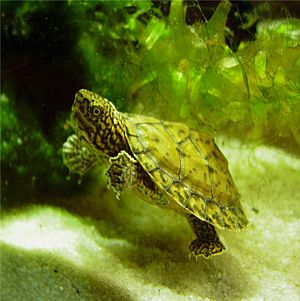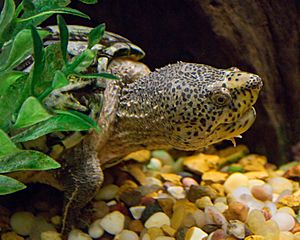Loggerhead musk turtle facts for kids
The loggerhead musk turtle (Sternotherus minor) is a type of turtle that lives in the southern United States. It belongs to the family called Kinosternidae.
Quick facts for kids Loggerhead musk turtle |
|
|---|---|
 |
|
| Hatchling loggerhead musk turtle | |
| Scientific classification | |
| Genus: |
Sternotherus
|
| Species: |
minor
|
Contents
Where They Live
The loggerhead musk turtle can be found in the southeastern United States. This includes states like Alabama, northern Florida, Georgia, and Mississippi. You can also find them in parts of Kentucky, Louisiana, North Carolina, Tennessee, and Virginia.
What They Look Like
The loggerhead musk turtle is named for its big head. It's much larger than the head of a common musk turtle. Adult loggerhead musk turtles are usually about 8 to 13 centimeters (3 to 5 inches) long. This is measured along the top shell, called the carapace.
They look a lot like the Razorback Musk Turtle. However, razorback musk turtles are a bit bigger. Loggerhead musk turtles have a flatter top shell. Razorback musk turtles have a taller, more dome-shaped shell. These turtles have small, fleshy growths called barbels only on their chin, not on their throat.
Their Home (Habitat)
Loggerhead musk turtles like to live in clean freshwater. You can find them in places like springs, streams, and rivers.
Reproduction
Loggerhead musk turtles lay eggs. This means they are oviparous. When they hatch, baby turtles are very small. They are about 2.2 to 2.8 centimeters (0.9 to 1.1 inches) long. Their top shell has three noticeable ridges, called keels. Their bottom shell, called the plastron, is pink and has no marks.
Images for kids
See also
 In Spanish: Sternotherus minor para niños
In Spanish: Sternotherus minor para niños



